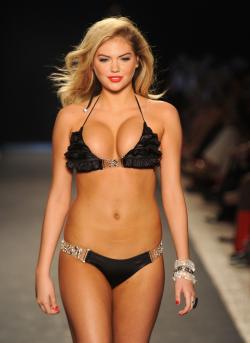Sports Illustrated’s annual swimsuit edition has always had a tenuous connection to the magazine’s central subject. The issue lately features naked women, their breasts and pelvises painted to look like bikinis, which is a form of clothing sometimes worn while swimming, which is also sometimes a competitive sport in which athletes wear a very different kind of swimsuit. From an advertiser’s perspective, though, the relationship is obvious: Guys like sports. Guys like women. Lite beer! Sports cars! Synergy!
But this year, SI hopes to tweak its barely-there offerings to appeal to the ladies in the audience—the magazine counts 18 million women among its readership. Women are “a part of our franchise that we can grow,” SI swimsuit editor M.J. Day told the New York Times. “Why not deliver more to them?” So when the issue hits stands Tuesday, can we expect to find Calvin Klein model Matt Terry’s ass wearing nothing but a thin coat of liquid latex? Nope! Women will get a six-page “style guide” featuring model interviews and makeup tips for helping “everyday beautiful women” look more like the exceptionally beautiful women who fill the issue’s pages.
“Men want her, women want to be her” is as tired an advertising cliché as “sex sells.” Men’s magazines sell women’s bodies. Women’s magazines sell women’s bodies. (And Details, a men’s magazine that actually features male bodies, is coded as gay.) For SI, leveraging male eye candy in the service of female anxiety seems like a cost-effective move. If it were to court female readers by integrating some itsy-bitsy Speedo’d men into the swimsuit spread, it would risk turning off the issue’s heterosexual male audience. But toss in some copy about achieving “tousled beachy hair,” and watch the women-focused ad dollars roll in (the inaugural guide is heavily-sponsored by Target).
Still, it’s a bit gauche to straight-up sell the male gaze to female readers. Women’s magazines soften the presentation by filtering their please-your-man copy through some you-go-girl branding. So it’s strange to see the beauty and body tips lifted out of the context of the “empowering” lady mag (Glamour’s “500 Ways to Just Be Yourself!”) and transplanted into the unabashedly objectifying world of the lads (Sports Illustrated’s “Kate Upton Goes Polar Bare … and Then Sizzles In Body Paint!”).
If Sports Illustrated really wanted to make a splash, it could take a cue from ESPN The Magazine’s annual body issue, which features actual athletes, male and female, in the nude. I guess in the end, SI doesn’t think it can shill a magazine to men and to women by acknowledging that together, its target readership is just people.
